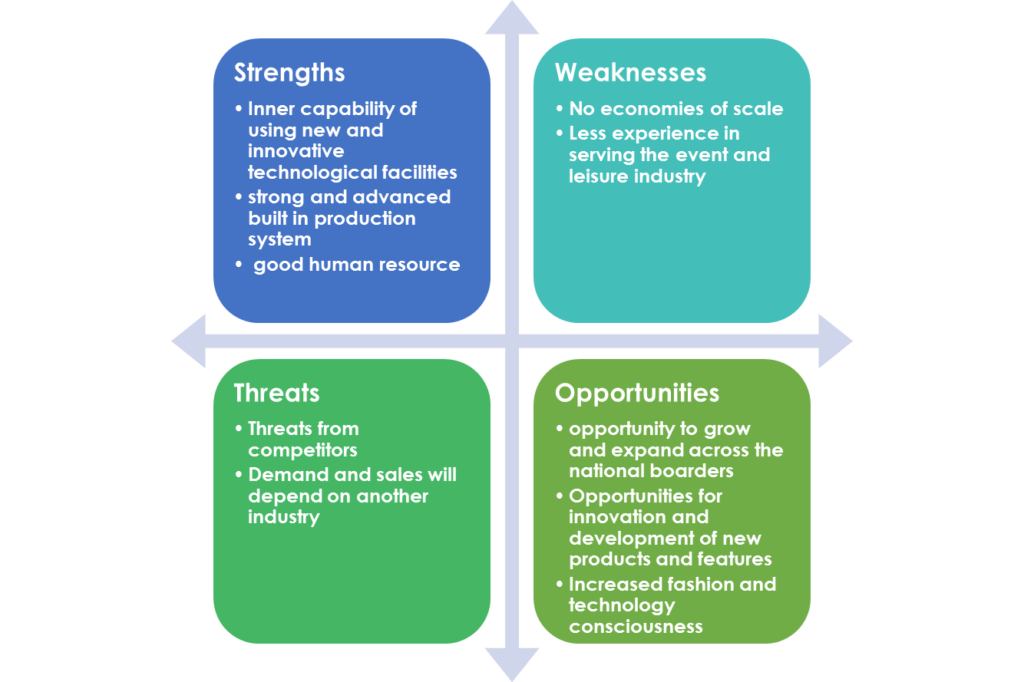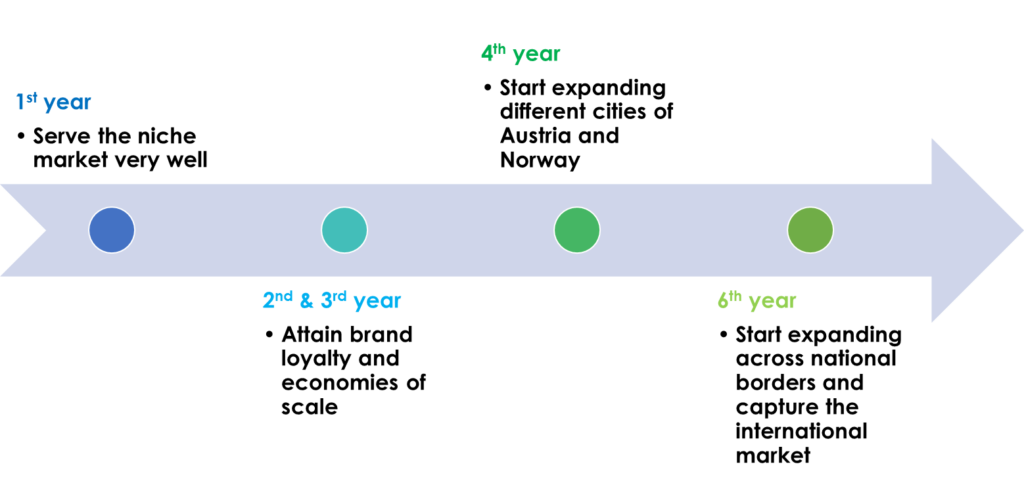Introduction
The project aims at applying the classroom contents in a real-life or fictitious company that is planning to exploit a niche market segment. Initially, the project plan is delineated. Then the main body of the report is presented. Firstly, the company’s introduction and SWOT and PESTEL analysis have been done on the company. Then, two models have been applied to the context of the company. And finally, the timeline for the growth and expansion has been presented.
The plan
Purpose of the project
This project aims to discuss and evaluate the potentiality of MGN SMART LED LIGHTING to enter into a niche market and then expand and grow in a broader market. In doing so, the company’s current situation, its potentiality and surrounding factors would be evaluated using different theories and models of niche marketing and joint marketing analysis tools such as SWOT, PESTEL etc.
Project goals and objectives
This project does have some specific aims and objectives to accomplish by the end of the project duration. Those are as follows-
- To identify the appropriate niche market and their potentiality for MGN SMART LED LIGHTING.
- To evaluate the cost and benefit of approaching this particular market segment and whether this market segment provides the company with the scope for concentrated marketing.
- To establish a strong position of MGN SMART LED LIGHTING in Austria’s event and leisure industry and promoted the use and effectiveness of energy-saving lighting products.
The company and its offerings’ effectiveness will be evaluated from the perspective of the event and leisure industry of Austria and some parts of Norway. This will be wholly related to the course module as the company will be targeting the niche market segment of the Event and Leisure industry in Austria and Norway.
The report
This report will evaluate and assess the potentiality of MGN SMART LED LIGHTING in the Event and Leisure Industry of Austria to capture a niche portion and grow further into a broader market. In order to do this, the company and potentiality will be evaluated from different perspectives.
The company, SWOT, PESTEL analysis
Introduction of the company and its product’s features
MGN SMART LED LIGHTING is one of the new and potential ventures in the lighting industry of Austria and incorporates an intelligent lighting control system that is automated luminance management through wearable sensors. The company uses bright lighting and mobile sensors in its products. The compatibility between bright lighting and mobile sensors allows the company to bring new and wide ranges of upgrades and lighting products. This technological advancement and capability of the company surely enhance its potentiality to innovate and bring new products. Thus, because of the resources mentioned above, the company has been able to incorporate the following features in its products-
- The product has a built-in sensor that turns on at dusk and off at dawn.
- The brightness is neither too bright nor too dim.
- Latest LED technology is used for power saving
SWOT analysis
In assessing the company’s potentiality, it is necessary to evaluate its internal strengths and weaknesses and assess its external opportunities and threats. The MGN SMART LED LIGHTING’s SWOT analysis is given below-
Strengths: The Company’s main strength should be its inner capability of using new and innovative technological facilities, and the company is doing it very well. Hence, its prime strength is its ability to use different technological facilities such as mobile sensors, the latest LED technology etc. The company already has a built-in system that it has been using in producing its products and services. The solid and advanced built-in production system has enabled the company to incorporate new technological innovations and features. Moreover, the company has an excellent human resource team as well who are helping the company to grow and provide better customer services.
Weaknesses: The Company has not grown so big yet; hence, it cannot enjoy the benefit of having economies of scale. Since it doesn’t produce on a large scale and targets a niche market segment, it doesn’t have the context of producing a large number of products. Moreover, the company is new and does not have much experience operating in a particular area or niche marketing.

Opportunities: Since the company is relatively new, it has ample opportunities to grow, do business and earn a lot. The event and leisure industry is multiplying worldwide; thus, it has the opportunity to grow and expand across the national borders of Austria. Technological advancement in Austria, particularly in the LED industry, has opened a vast area for innovation and new products and features to capture the market. The changing demand of the consumers and the increased fashion consciousness of the modern-day people have also opened vast opportunities for the company to go further, even to the doors of households and accommodation service to beautify and modernise their residents and houses.
Threats: Despite having many opportunities to be optimistic, there are a few issues that the company should be aware of. The LED light industry is almost a fragmented industry that means many companies are already operating in the industry. Hence, it has the chance of being dominated by other companies and losing market share to them. Moreover, even though it is a LED light manufacturing company, it targets to serve the event and leisure industry. Henceforth, its targeted industry is not directly related to its products. Thus, the demand for its products will mostly be dependent on the condition of another industry.
PESTEL analysis
PESTEL analysis incorporates the political, economic, social, technological, environmental and legal conditions of the particular region, area or country in which a company is operating. All these factors are the elements of the macro-environment for a company. The PESTEL analysis of Austria is discussed below.
Political: The political condition of Austria is relatively stable and favourable for any kind of legal businesses. It is a federal democratic country, and its federal area consists of nine provinces. In every election, the citizens of Austria get to select their preferred party to rule the country. There is hardly any political disharmony and turmoil (Migration.gv.at, 2019). Hence, MGN SMART LED LIGHTING will enjoy a favourable political condition for operating its business in Austria.
Economic condition: Austria is a well-developed and economically stable country. The GDP of Austria was 416.6 billion USD in 2017. And the country is having a GDP growth rate of around 2.5% every year (Anon, 2019). The country is blessed with a very skilled labour force and a high standard of living. Hence, MGN SMART LED LIGHTING will be in a favourable economic condition to operate.
Social factors: The social factors in Austria are also much favourable for doing technology-related businesses. Austrian citizens are very skilled and financially solvent, and they lead a very high standard of life. Hence, they prefer travelling and taking breaks and leisure in different amusement parks and areas as their means of recreation and relaxation (European Economic and Social Committee, 2019). Thus, the social factors of Austria will have a positive impact on the business of MGS SMART LED LIGHTING.
Technological factors: Austria is one of the leading technologically developed and advanced countries in the European Union. It has established itself as the most suitable country for research, technology and innovation evaluation. All sorts of modern-day technological features and facilities are available and used by businesses and organisations (Schuch, 2019). Thus, the MGN SMART LED LIGHTING will find it very comfortable and easy to research, innovate, and incorporate all the new technological features and facilities available to bring better products and serve the consumers better.
Environmental factors: Austria is one of the most prominent countries in Europe in terms of doing environment friendly businesses. The authority of this country is strictly controlling the environment and ensuring that companies are following the environment policies properly to protect the environment from being damaged. Henceforth, waste management, recycling business, pollution-free boiler instalments, renewable sources of energy, and power-saving technological products and services are encouraged by the government (Investinaustria. at, 2019). MGN SMART LED LIGHTING is also focusing on renewable energy sources and offering lighting systems that would save energy and enjoy operating businesses there.
Legal factors: The companies in Austria must abide by the rules and regulations of the government and relevant authorities. For businesses exporting or across the borders, the companies must comply with the Department for International Trade (Icaew.com, 2019). Moreover, the technology companies such as MGN SMART LED LIGHTING must ensure their compliance with environmental laws, company laws, tax laws of the government of Austria, safety laws, employment laws, wage laws etc. Complete compliance with these laws will help the company operate its business smoothly and expand further afterwards.
Theory and model application to MGN SMART LED LIGHTING
Different theories and models can be applied to understand the business and potentiality of the company to serve the niche market and grow further in the future. Analysed the potentiality of the MGN SMART LED LIGHTING Long tail phenomenon by Anderson and Five Product Levels by Kotler.
Long Tail Phenomenon
The long-tail phenomenon was first introduced by Anderson in 2009. This theory incorporates business strategies taken by the businesses to generate higher profit without producing the generalised best-selling products rather than by adding differentiated features that would serve the needs of specific niche markets. In this process, companies don’t tend to produce the best or most popular products. Instead, they try to find ways to add extra and differentiated features to their products that different niche market segments would accept. In this process, companies can make a massive profit by serving many niche segments of the market untouched or underserved by the existing other companies and their existing products (Benghozi, & Benhamou, 2010.).
The theory is also applicable to the case of the MGN Smart LED lighting company. This company is not trying to approach the whole market segment of Austria to serve its products. Instead, the company targets the niche segment of Guessing, Southern province of Austria & the New Toven Tunnel in Nordland, Norway, of the event leisure industry. The company is differentiating itself by adding some extra features that are not popular among the consumers and other companies.

The company will be adding some exceptional features that are not usually demanded by their regular customers, such as businesses, corporations, and other organisations who need to use lighting systems in their premises and LED festoons, banners and billboards. Those extra features include using a mobile sensor that will make sure that the lights are on at dusk and off at dawn. It would also get adjusted with the level of lights available in the environment and change its colours according to the choices of the visitors and consumers. But this feature is not that much required for standard business organisations. But it is indeed required by the companies involved in the event and leisure industries of Austria. Those companies need to have enough facilities to entertain the visitors and consumers. Hence, one way of keeping the environment pleasant and amusing is to ornament it with beautiful lighting. Thus, the residential hostels, resorts, hotels, restaurants, amusement parks etc., from the event and leisure industry will surely buy the products of the MGN SMART LED LIGHTING. Additionally, the company is using the latest technologies and facilities to build its products so that its products will be consuming less power and energy to light than what the other companies’ products will be consuming. This indeed serves the crucial purpose of companies in the leisure industry to spend more on entertaining travellers and visitors in multiple ways. When the companies can save from their lighting expenditures, they will have more money to develop and design better facilities for their consumers.
The discussion above has made it clear differentiating features added by MGN SMART LED LIGHTING will attract the consumers of event and leisure industries. The companies from this industry will purchase from MGN SMART LED LIGHTING for its extra added features, which will help the company earn greater profits. This is how the long tail theory will work for MGN SMART LED LIGHTING in generating greater profits with low sales volume by serving the niche market segment.
Product level theory
The product level theory was developed by the renowned economist Philip Kotler around the 1960s. The economist argued that a company could serve its consumers by developing its products to meet a different level of expectations from the products by the consumers. According to his theory and model, there are five expectation levels that the consumers can perceive from a company (Agyekum, Haifeng & Agyeiwaa, 2015). Those five expectation levels are as follows-
Core benefit: Core benefit is the primary expectation that the consumers can have from a company. In this case, the least that product can offer to the consumers is served by the company. For example, suppose the lighting products are used to analyse. The products that only give light and eliminate the darkness and do not even have the controlling system can be attributed as the core products.
Generic products: Generic products are the elementary level of the products that incorporate some of the needed features and facilities to use. In the example of lighting products, the lighting that can be controlled for making it on or off can be attributed as a generic product.

Expected product: Expected products include all the necessary features and attributes to use for personal and commercial purposes. But the products at this expected level do not incorporate any special features that are not mandatory to be incorporated to use the product in the example of the lighting industry and lighting products. The lights that can eradicate darkness can be controlled to make on or off have multiple colours, and some other necessary benefits can be attributed as the expected products.
Augmented products: Augmented products refer to the extra added features and advantages to the products that differentiate the company and its products from its competitors. The features incorporated in this level are not mandatory to have. Still, these features give clear distinction to the company, and the company will enjoy extra advantage to sell the products to specific customers and niche markets who will prefer these augmented products rather than the generic and expected products. In the example of lighting products and the case of MGN Smart LED Lighting, the company is offering augmented products to its niche market segments of the event and leisure industry. The company’s offerings to its lighting products include mobile sensors that would automatically adjust the brightness level with the environment, and it also uses power-saving technologies. These two added features have differentiated the company from its competitors and attractive to its targeted niche market segments.
Potential products: Potential products are products with potential features that can be added in the future. The companies used to invest in research and development activities to innovate and find potential features to the existing products that would give the more significant distinction from the competitors. The MGN Smart LED Lighting will have to be conscious of the potential features that it can add to differentiate it from the competitors further and grow across the borders.
The future and growth plan for MGN
The company is primarily targeting a niche market of Austria and Norway’s event and leisure industry. From the above discussion, it is evident that the company has excellent prospects in serving the niche market segment of the event and leisure industry. Suppose it can keep its quality and distinction properly for a more extended time in serving this market. In that case, it will surely enjoy more significant revenue and success in the coming future. Hence, the company’s future is very much prospective. And yes, there is scope for expansion for the company. In doing so, the company needs to serve the current niche market very well. If it can do this primary task very well, it will surely gain brand acceptance and brand loyalty. It will also enjoy a good reputation for its innovative product features such as mobile sensor, renewable energy souring and energy-saving technologies within the operation of the first three years. After gaining enough reputation, it should start proceeding for further expansion. Initially, it should focus on expanding across the other cities of Austria and Norway from the fourth year. After serving within the national border for a few years, to be precise, for at least 2 years (4th and 5th year), it will understand the market mechanism in a better way. In the meantime, it will also gain further brand acceptance and brand loyalty. Then the company can start preparing for expanding across national borders and capture the international market.

It should start progressing to expanding into the international market from the 6th year. Initially, the company is recommended to exploit the nearby countries, for example, the other countries of the European Union. If it gets success in serving those areas, it can then decide to go further. The unique point of sales for the company is its differentiated features and innovative product designs that specialise its products to save more power and energy. And the company is recommended to keep its focus on these two dimensions for the rest of the journey and gain a distinctive brand image for its specialisation in innovation, product differentiation, and environmental concern.
Conclusion
Innovation and differentiation are two of the most used strategies by businesses to sustain in the long run. The MGN LED Smart lighting is also doing the same thing. However, to succeed in the long run, the company must continue its focus on research and development and innovation of new and environmentally friendly products. It also needs to be aware of serving its targeted niche market properly.
References
Agyekum, C.K., Haifeng, H. and Agyeiwaa, A., 2015. Consumer perception of product quality. Microeconomics and Macroeconomics, 3(2), pp.25-29.
Anon, (2019). [online] Available at: https://theodora.com/wfbcurrent/austria/austria_economy.html [Accessed 30 Nov. 2019].
Benghozi, P.J. and Benhamou, F., 2010. The long tail: Myth or reality?. International Journal of Arts Management, 12(3), pp.43-53.
European Economic and Social Committee. (2019). The economic and social situation in Austria. [online] Available at: https://www.eesc.europa.eu/en/our-work/publications-other-work/publications/economic-and-social-situation-austria [Accessed 30 Nov. 2019].
Icaew.com. (2019). Doing business in Austria. [online] Available at: https://www.icaew.com/technical/by-country/europe/austria/doing-business-in-austria [Accessed 30 Nov. 2019].
Investinaustria.at. (2019). Environmental Technologies in Austria | Invest in Austria. [online] Available at: https://investinaustria.at/en/sectors/environmental-technologies/ [Accessed 30 Nov. 2019].
Migration.gv.at. (2019). The political, administrative and legal systems. [online] Available at: https://www.migration.gv.at/en/living-and-working-in-austria/austria-at-a-glance/the-political-administrative-and-legal-systems/ [Accessed 30 Nov. 2019].
Schuch, K. (2019). Research, Technology, and Innovation Evaluation in Austria. [online] Ostaustria.org. Available at: https://ostaustria.org/bridges-magazine/volume-37-may-15-2013/item/8102-research-technology-and-innovation-evaluation-in-austria [Accessed 30 Nov. 2019].





